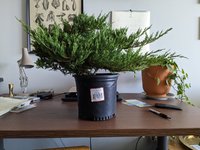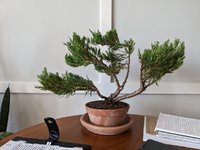For the first time, I went and picked out a juniper from the garden center with the plan of paring it down into a bonsai.
I like the direction it's heading, but would like some advice on where to go from here.
Welcome to the journey! Bonsai is a deep and can be incredibly enriching art. The first step is just to get started and work on material, so congrats on the making the move.
There is a lot involved in the makings of a bonsai. To simplify it we can break down bonsai art in 2 aspects.
1) Horticulture - A tree is alive so we are bound to the conditions that enable the tree to grow.
Think how work with the growth characteristics of a tree to create branches, maintain health, as well as how the tree responds to our work and the environment. If I cut a branch how will the tree respond? How will getting more or less sunlight on an area affect the growth? Working with the health of a tree and how a tree grows is the basis of all bonsai and the most important part, so it should always be the consideration behind all work.
2) Aesthetic - In general (omitting different styles or bonsai philosophies) people are generally attracted to bonsai in part from its ability to capture nature and to display it in a scaled down, but equally grandiose form. If we follow this motivation, we need elements in our bonsai that make it feel like a "big small" tree. Meaning our building blocks such as branches, movement, foliage pads that make up your design get proportionally smaller relative to a full size tree. Not necessarily saying that we are always emulating nature but framing these elements in smaller scale gives a small tree more impact.
Assessing your tree, you've opened up some branches and started to show some branch lines. This is a start and is means of showing directionality or movement in the tree. It feels "windswept" inspired, although I am not sure if that is your intention. The left trunks all move left with the foliage, but the right most trunk moves right. Generally we can set a theme or tell a story with our bonsai. Have you considered shortening the foliage on the right trunk while maintaining the length on the left trunks to give a net movement to the left and tell the story of windblown influence from right to left?
There are so many more layers, but it is kind of too much to discuss in the start. I will leave you with these questions for your own research.
- How can I create age in my bonsai?
- Can the work I put in now, be built upon in the future?
- What are trees/bonsai I am inspired by?
Some recommendations:
- Seek out a local bonsai nursery, club, or group in your area. Meeting other enthusiasts with more experience as well as physically seeing nicer quality trees can expedite your learning. A good habit is to look at trees you like and think about how it was made. Better yet if you can ask the creator directly who can give you insight into the tree building process.



